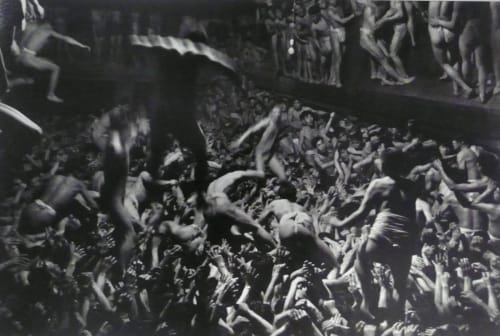Born November 16, 1908 in Whittier California, Bristol studied at the just-opened Art Center of Los Angeles, where he was exposed to the subtle, painterly images of Edward Steichen and the powerful industrial landscapes of Margaret Bourke-White. In 1933, Bristol moved to San Francisco to pursue commercial photography, renting a studio a few doors down from Ansel Adam’s gallery near Union Square. Through Adams, Bristol befriended members of the famed “Group f/64”, including Edward Weston, Dorthea Lange and Imogen Cunningham.
In 1941, after the attack on Pearl Harbor, Bristol leapt at the opportunity to work as one of a select group of five photographers documenting the war under the direction of the influential Edward Steichen. Bristol photographed behind the scenes of key Naval battles, including the invasions of North Africa, Okinawa and Iwo Jima. Following the war, Bristol brought his family to Japan where he photographed the war’s devastating legacy, as well as the vestiges of traditional Japanese life. In Tokyo, he established the East-West Photo Agency and began selling his photographs of Southeast Asia to virtually every pictorial magazine in Europe and the United States. He also published several books under the East-West name focusing on Pacific Rim countries in transition.
In 1956, devastated by the suicide of his wife, Bristol burned all the negatives and photographs that he kept at his seaside house in Japan, effectively ending one of the most intense photographic careers of his time. His remaining photographs were packed into footlockers, stored, and left untouched for nearly thirty years.
Having put photography behind him and remarried, Bristol was reminded of his past when his 15-year old son Henri came home from high school in 1985 with an assignment to read The Grapes of Wrath. Only then did Bristol open the musty footlockers that kept a lifetime’s worth of images and memories. When he saw the tired, dignified faces of the migrant farm workers, he couldn’t help but regret that his life’s work had been all but forgotten in the three decades since he’d put away his camera.
Horace Bristol died in August 1997, but not before seeing his photographs exhibited in galleries and museums throughout the United States and Europe, and a book of his work published in his name: Horace Bristol, An American View (Chronicle Books, 1996). Currently, his work is on view at the Los Angeles County Museum of Art as part of their Made in California exhibition, and the Getty Museum recently acquired photos from The Grapes of Wrath series for their collection.
Shinto Shrine Melee, New Year’s Day, Japan 1946 depicts a ritual practice carried out to establish a connection between present-day Japan and its ancient past. Founded in 660 BC, Shinto is the largest religion in Japan and is practiced by nearly 80% of the population. It is defined as an action-centred religion, focused on ritual and public shrines devoted to the worship of a multitude of gods. Some shrines have festivals that attract hundreds of thousands, especially in the New Year season.
In total we will be exhibiting 40 works from 18 artists.
Contact for more information or EXPLORE THE EXHIBITION PAGE

